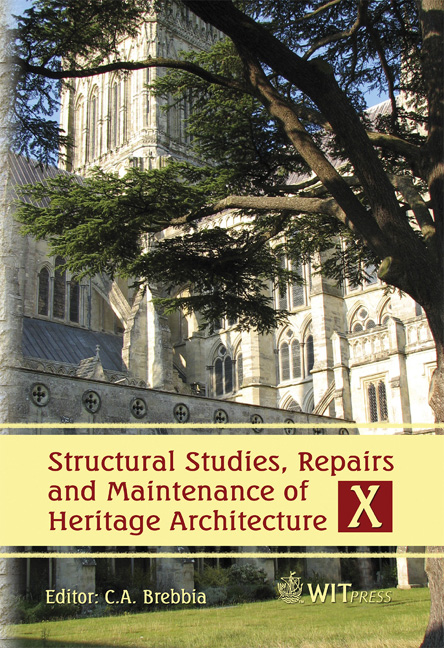Analysis And Simulation On Unequal Settlement Of Ancient Masonry Pagodas
Price
Free (open access)
Transaction
Volume
95
Pages
9
Published
2007
Size
712 kb
Paper DOI
10.2495/STR070431
Copyright
WIT Press
Author(s)
J. L. Yuan, J. Wang & H. Z. Lv
Abstract
This paper analyzes the main causations that make the unequal settlement of ancient masonry pagodas, and illustrates the influences induced by adverse factors. A famous Chinese leaning pagoda, Huqiu pagoda in Suzhou city, has been selected as a research object, to study the characteristics of applying modern analysis technique to ground deformation of ancient masonry pagodas. A practical simplified model was developed, and the inclination status of Huqiu pagoda has been simulated by finite-element analysis software ANSYS. Keywords: ancient masonry pagoda, unequal settlement, influencing factor, simplified model, modeling technology. 1 Introduction The masonry pagoda is a main type of the Chinese pagodas. Because masonry structures have big deadweight and are sensitive to the deformation of the ground, the many masonry pagodas are on the leaning status. In order to control and strengthen the inclined masonry pagoda, the reasons of inclination and the infection of the unequal settlement of ground must be analyzed. The unequal settlement of ancient pagoda is the embodiment of the ground deformation virtually. In the analyzing process of leaning status of ancient pagoda, we should give priority to the ground deformation, and consider added deformation aroused by deflection of center of gravity of superstructure. On the long-term load, the compress deformation of subsoil under the ancient pagoda is basically completed. So, in the analysis of ground deformation, we may not consider the influence of time, but calculate final settlement of ground directly. The method of analyzing final settlement of ground is usually plotted into classical theory and numerical simulation, for example, the layered summation
Keywords
ancient masonry pagoda, unequal settlement, influencing factor, simplified model, modeling technology.




